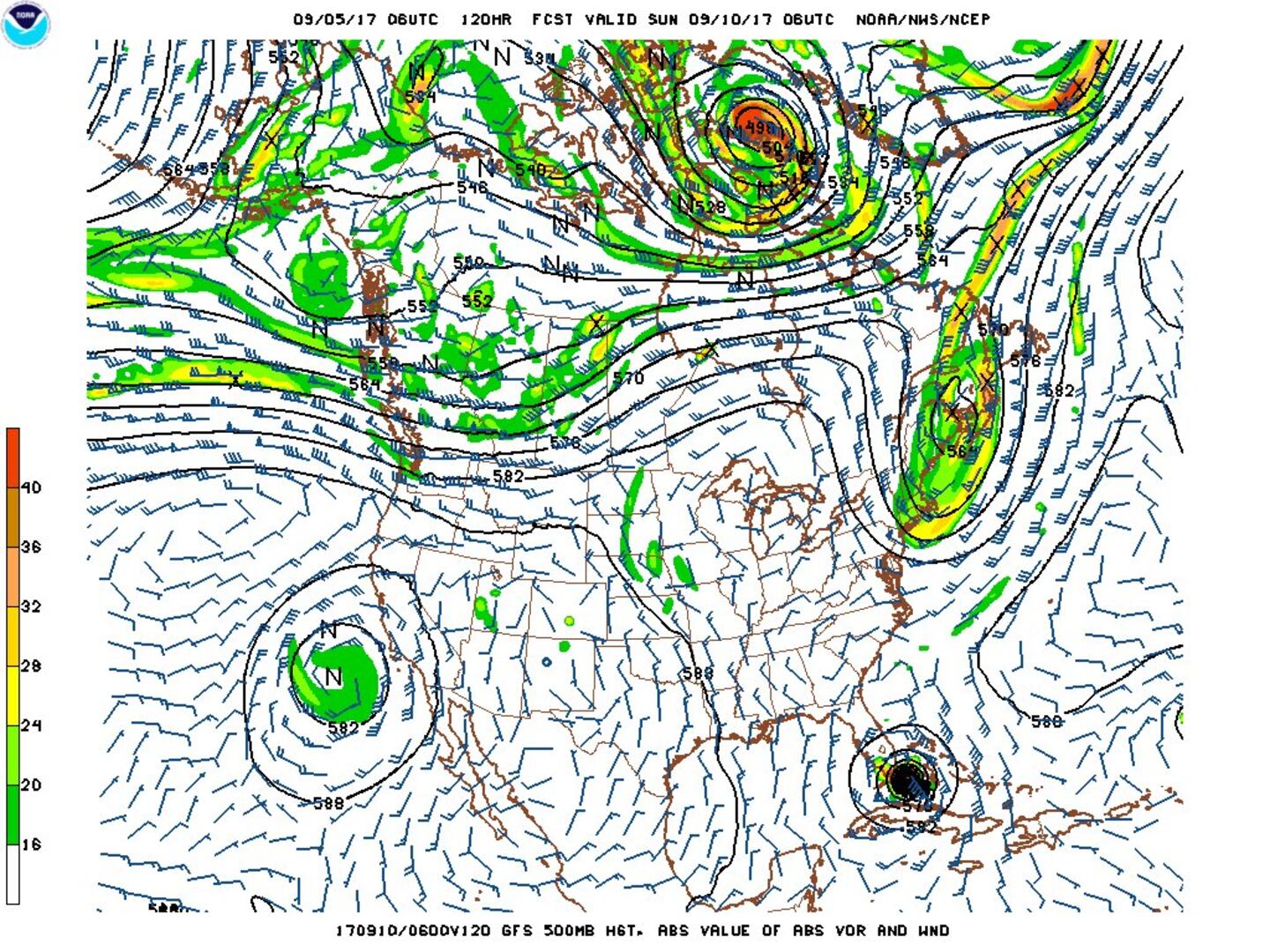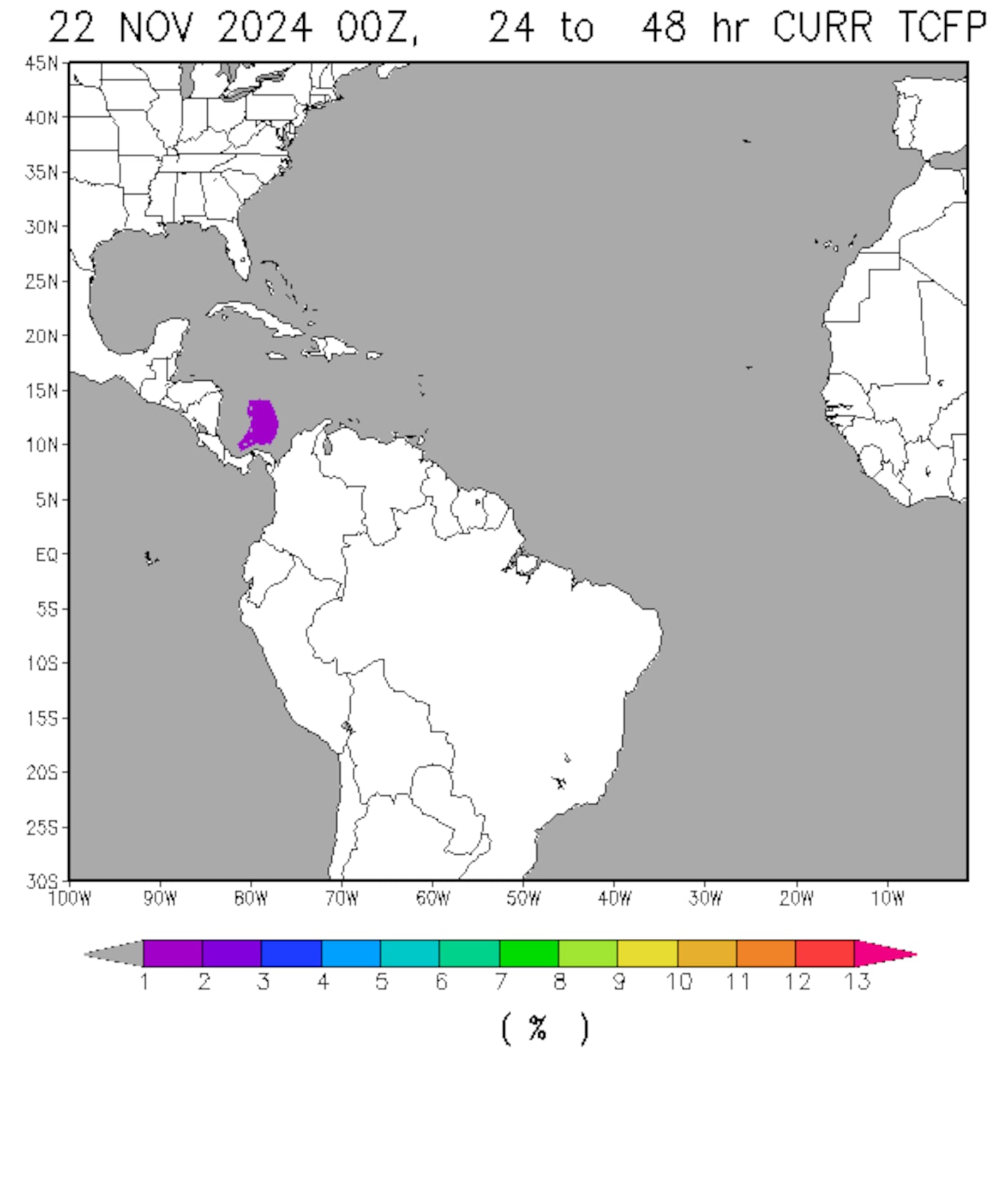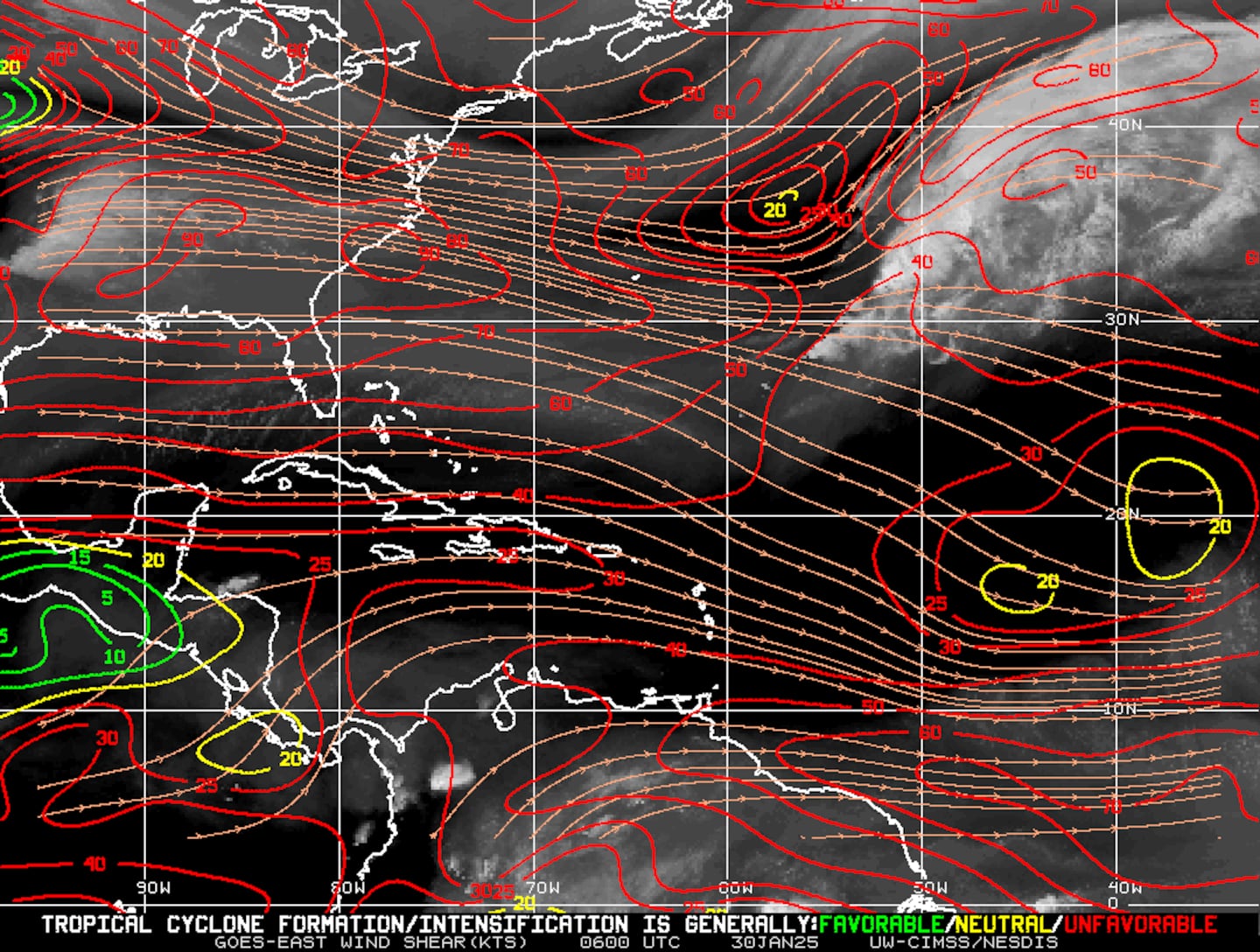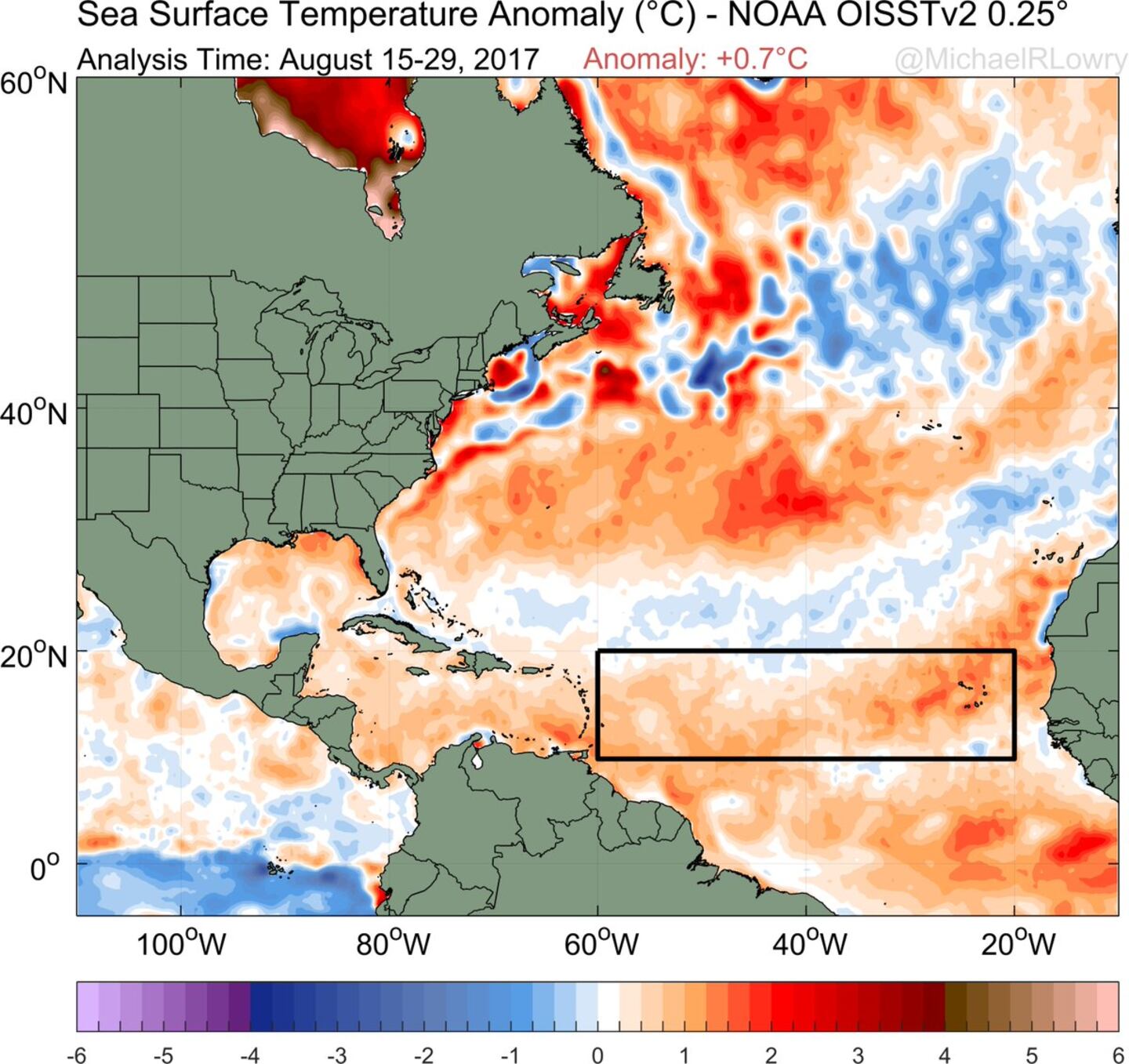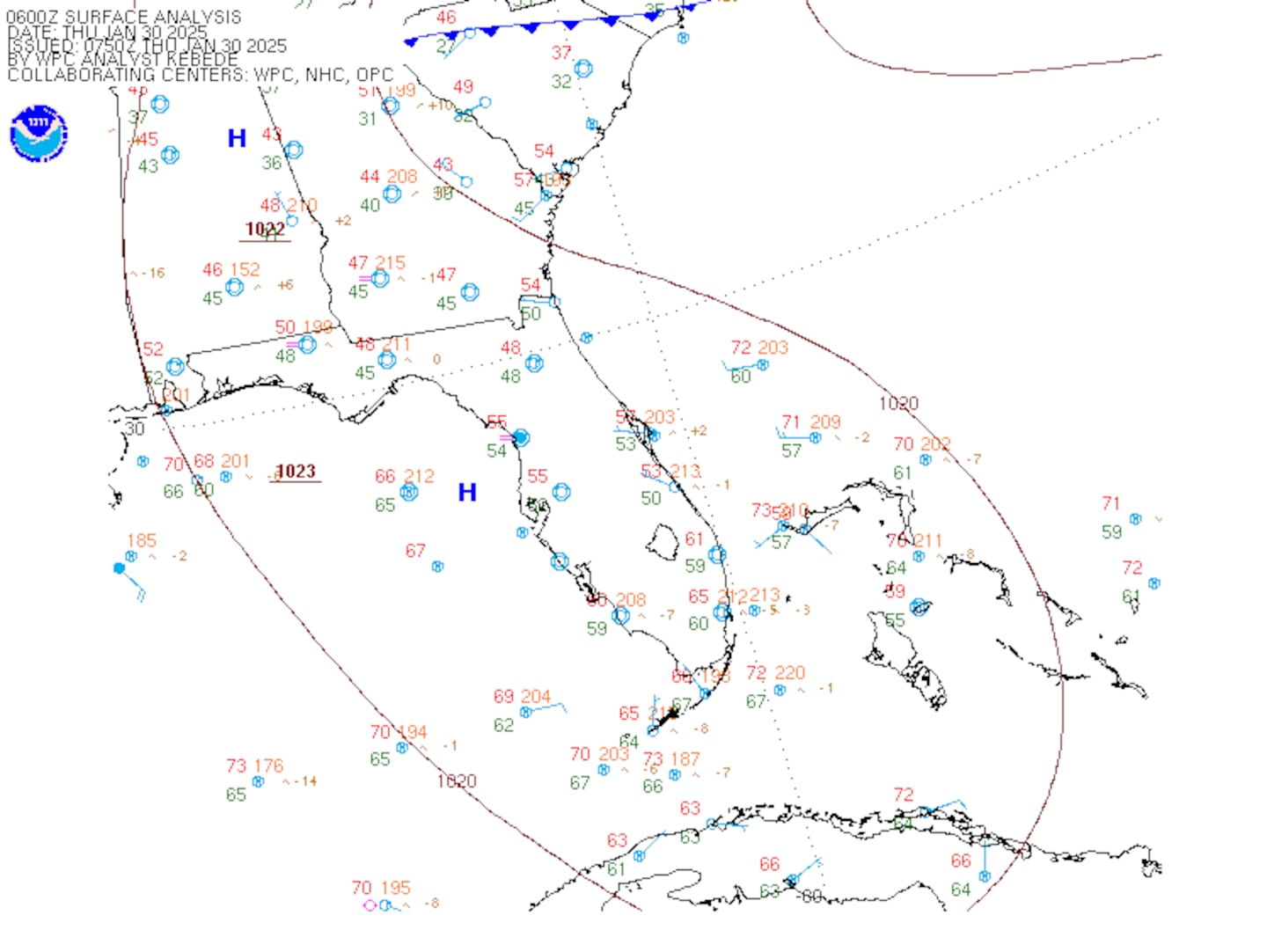Sept. 5, 2017 — Good deal of uncertainty continues regarding the final path of Irma in the long range.... model shift to the west continues.... Hurricane WARNING Northern Lesser Antilles, Virgin Islands & Puerto Rico... hurricane WATCH Dominican Republic....
The "Buresh Bottom Line" is: stay tuned!... Always be prepared!..... City of Jacksonville Preparedness Guide... Georgia Hurricane Guide. It is still too early to pinpoint local (Jacksonville/NE Fl./SE Ga) impacts, but I am rather certain - higher than 50% - that there will be at least some impact Sunday into early next week in the form of heavy rain, strong onshore flow & winds/possible storm surge & isolated tornadoes.
"Irma" has turned into a classic deep tropics long track (trans-Atlantic) hurricane. Changes in structure (eyewall replacement cycles) from time to time will lead to fluctuations in intensity but Irma - overall - should remain a major hurricane though possible land interaction with the Greater Antilles late in the week/weekend which could cause more significant changes in strength. Satellite imagery shows a well developed hurricane with a clear eye & excellent outflow over the top. NOAA hurricane research planes are flying through (avg. 1,000-10,000 feet) & around "Irma" pretty regularly which will give us a better idea of the structure & intensity & - above all - hopefully add to some consistency & accuracy in model forecasts assuming better analysis/input for the models.
Some of the plane recon is being used in the model & might be part of the reason for the most recent big track adjustments by the models.... in addition to it being quite clear that a big trough moving into the Eastern U.S. will miss "Irma" (more on that below). And this from the NHC:
"Six hourly upper-air soundings will begin at 1800 UTC today over the central United States to better sample the upstream mid-latitude trough. In addition, the NOAA G-IV aircraft will begin sampling the environment around Irma this afternoon and evening, and these data will be included in tonight's 0000 UTC model runs." [00Z = 8pm EDT.... Central U.S. sounding sites: Bismarck, Dodge City, Amarillo, Topeka, Oklahoma City, Springfield, Detroit, Minneapolis, Rapid City, North Platte, Aberdeen & Omaha... + extra soundings from San Jaun, Puerto Rico."
I cannot emphasize enough that it's too early - & would be premature & irresponsible - to try to peg exactly
where Irma is going to go in the long run &, therefore, it's still early to determine which parts of the U.S. might
be adversely impacted. It's looking more & more like the Bermuda high over the Atlantic will hold strong enough to force "Irma" as far west as at least the Florida Straits & possible the far Eastern Gulf of Mexico. Most likely
closest approach to Fl. will be over the weekend into next week. Stay cool, calm & collected... NOW is the
time to prepare:(1) peak of the hurricane season is upon us
(2) you'll be prepared for anything mother nature throws at us - hurricane, lightning, flooding, tornadoes, etc. Preparations do not need to take a long time nor do preparations need to be expensive. But preparing now will offer peace of mind for when & if a storm is headed your direction & will also give you a better chance to survive the storm then allow you thrive after the storm.
(3) know your evacuation zone
Forecast models continue to jump around though have - as a whole - definitely shifted west & are a little slower, but I would not be surprised to see another shift at least somewhat east. The GFS & European are very similar pointing at the west coast of Fl. or "up the spine" while the UKMET (reliable last season) is farther south & west & slower placing Irma over Cuba for a good part of the weekend which would be bad news for Cuba but likely weaken the storm - at least for a while - before approahing the U.S.. More adjustments & changes are ahead - it would be prudent to not hang on each & every individual model run but rather look at the bigger picture in the coming days. The mountainous terrain of Hispaniola & Cuba just might come into play. And any building/movement &/or strengthening of the Bermuda High - which has been a strong mainstay for months - makes storm recurvature more difficult - this is a sentence have had in this blog since early last week & is obviously now coming into play.
A rather deep upper level trough will move into the Central/Eastern U.S. the next few days which will play a pivotal role in the eventual movement of "Irma" (that's why extra soundings are being released in the Midwest). The GFS model upper level (500 mb) chart below for Fri., 09/08 shows the strong trough. There is a clear alleyway along the U.S. east coast but all indications are that this strong trough will be moving quickly & that it will not pick up Irma. As the trough lifts out, a strong surface high will build into the Northeast U.S. which will block Irma from getting too far north while an upper level ridge builds underneath the departing trough. This puts the coastline from Fl./Ga. to Virginia on high alert!.... with a move that would be very near if not into Florida & quite possibly close to Jacksonville at one time or another. And by no means is this set in stone! There will still be a softness in the flow over the Southeast U.S. which is what Irma should follow later in the weekend into early next week.
The GFS model is pretty consistently shifting west to a hit on the U.S. coast, aimed on Fl. (though some of its intenstiy forecasts are obviously too deep).... & the European is now there too. It's worth noting that the European did a pretty good job last year with an intensifying southwest moving Matthew which is what Irma is doing (W/SW). The Euro model then, however, played Matthew too far north & east last year (too far away from the U.S.). So I'm concerned about a right - or east - bias once Irma starts to get tugged again more west then northwest. In fact, the UKMET - as mentioned earlier - takes Irma over Cuba for more than 24 hours.... though the model has had a slight southern bias on Irma so far. I still believe a rather abrupt turn to the north will occur in the long run. The question becomes when & where. But it is clear - to me - the big eastern U.S. trough will be fast moving & transient & that "Irma" does not get sucked up into the trough & taken far to the east over the Atlantic. In other words, no escape route & the question is what part of the U.S. coast line is most at risk.
SUMMARY:
STILL VERY EARLY on how the steering currents will play out by the weekend as "Irma" makes its move W/NW then more northward. Global models will continue to try to correct for the better part of the next several days, especially given new analysis data provided by hurricane hunter & research aircraft. A combination of plots from each model's run (ensemble) points to near Florida by the weekend/early next week but with any part of the U.S. coastline potentially at risk for a landfalling hurricane. I cannot emphasize enough the uncertainty at this point.
People have been asking about a "way out" - where Irma doesn't impact Florida at all ... or even the U.S. While that seems unlikely, there are 2 possibilities that aren't off the table:
(1) land interaction with Dominican Republic/Haiti &/or Cuba
(2) the upper level high pressure ridge bridges between the Bermuda high over the Atlantic & the Southwest U.S. This would really have an impact keeping Irma on a much more westerly or even southwesterly path. Not likely but something to look at & to at least ponder.
Upper level (500 mb) chart below from GFS for early Sunday:
I am also keeping a watchful eye on the Western Gulf of Mexico (yet again!) as indications are that low pressure will try to develop over the Western Gulf later this week & could become tropical. It looks like this potential development will be guided by the S.W. U.S. ridge which should keep the system tucked over or near the Bay of Campeche which would mean most of the heavy rain would stay south of water-logged/Harvey-wary Texas & Louisiana.
.... & there's a strong tropical wave that continues to organize over the Central Atlantic well to the east & southeast of "Irma". This system has a good chance to become trapped over the Central Atlantic where the disturbance could sit & spin for many days. In fact, I'm concerned about an upper level ridge eventually rebuilding to the north across the Atlantic & trying to push the system at least some semblance of west.
"Irma" model plots....
Fascinating imagery(!) from CIMMS, University of Wisconsin, Madison - Microwave radar-simulated imagery showing Irma wrapping up... click here for full definition..... as "Irma" rapidly tightens up then weakens....
Tropical disturbance over the Central Atlantic to the southeast of "Irma"... & developing disturbance SW Gulf of Mexico....
Very warm ocean water ahead for Irma:
Even more telling - the oceanic heat content showing a wealth of deep warm water over the SW Atlantic/Caribbean & Gulf of Mexico:
And let's dust off our Pacific typhoon teleconnection for trying to forecast "Irma" - it's not quite exactly lined up but is becoming close enough to possibly draw some parallels. The 500mb chart below from the GFS for the N. Pacific to the Northern U.S. shows trough, ridge, trough, ridge, trough - the last trough being over or near the Eastern U.S. (it's what's picking up the "Harvey" remnants). The W. Pacific trough is picking up typhoon "Sanvu" keeping the tropical cyclone very near or to the immediate east of Japan with a recurve into the N. Pacific. This MIGHT be an early clue that at least some semblance of troughing or alleyway will remain in place over or near the Eastern U.S. which COULD draw Irma northward near or over U.S. coast.
0
Satellite imagery below shows a band of clouds over the W. Atlantic - a weakening front that will be reinforced later this week & is part of the weakness in the upper level flow that gradually tries to pull Irma northward....
1
Tropical cyclone formation probability over next 1 - 2 days:
Wind shear analysis (red is stronger shear).....
Water vapor imagery shows quite a bit of dry air in the vicinity of "Irma" for the moment but the mature hurricane is simply shrugging it off... note very moist air over Gulf & SW Atlantic:
Imagery below courtesy CIMMS shows African Saharan dust (orange & red)....
"Tis the season for tropical waves rolling west off Africa....
The main development region (MDR) shows above avg. temps. - in fact - only 2005 & 2010 were warmer. The deep warm ocean water can "energize" tropical cyclones:
SE U.S. surface map:
0
Surface analysis centered on the tropical Atlantic:
1
Surface analysis of the Gulf:
2
Caribbean:
3
Cox Media Group


